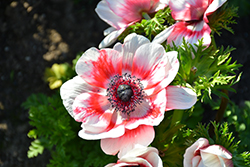Height: 18 inches
Spread: 6 inches
Sunlight:
![]()
![]()
Hardiness Zone: 7b
Other Names: Poppy Anemone
Group/Class: Mona Lisa Series
Brand: PanAmerican Seed
Description:
This variety forms a dense clump of ferny foliage in spring, then produces stunning white flowers with red rings; very pretty when massed in the garden or along borders
Ornamental Features
Mona Lisa Bicolor Red Windflower is smothered in stunning semi-double white buttercup flowers with black eyes and a red ring at the ends of the stems from early to late spring. The flowers are excellent for cutting. Its ferny leaves remain green in colour throughout the season.
Landscape Attributes
Mona Lisa Bicolor Red Windflower is a dense herbaceous perennial with an upright spreading habit of growth. Its relatively fine texture sets it apart from other garden plants with less refined foliage.
This is a relatively low maintenance plant, and is best cleaned up in early spring before it resumes active growth for the season. It is a good choice for attracting bees and butterflies to your yard. It has no significant negative characteristics.
Mona Lisa Bicolor Red Windflower is recommended for the following landscape applications;
- Mass Planting
- General Garden Use
Planting & Growing
Mona Lisa Bicolor Red Windflower will grow to be about 14 inches tall at maturity, with a spread of 6 inches. Its foliage tends to remain dense right to the ground, not requiring facer plants in front. It grows at a medium rate, and under ideal conditions can be expected to live for approximately 10 years. As an herbaceous perennial, this plant will usually die back to the crown each winter, and will regrow from the base each spring. Be careful not to disturb the crown in late winter when it may not be readily seen! As this plant tends to go dormant in summer, it is best interplanted with late-season bloomers to hide the dying foliage.
This plant does best in full sun to partial shade. It prefers to grow in average to moist conditions, and shouldn't be allowed to dry out. It is not particular as to soil type or pH. It is somewhat tolerant of urban pollution. This is a selected variety of a species not originally from North America. It can be propagated by division; however, as a cultivated variety, be aware that it may be subject to certain restrictions or prohibitions on propagation.
Disclaimer - This resource is provided for informational purposes only and does NOT reflect current availability. Inventory varies seasonally, so we cannot guarantee that every plant will be in stock at all times - please contact your favourite GardenWorks location directly for current availability. It does not include our entire inventory of plants, so be sure to visit GardenWorks to see varieties that may not be represented on this list.

